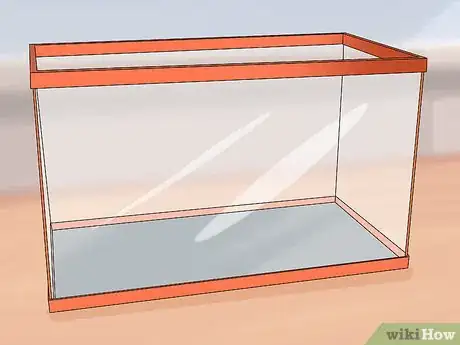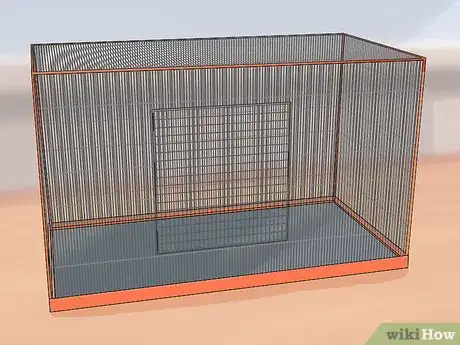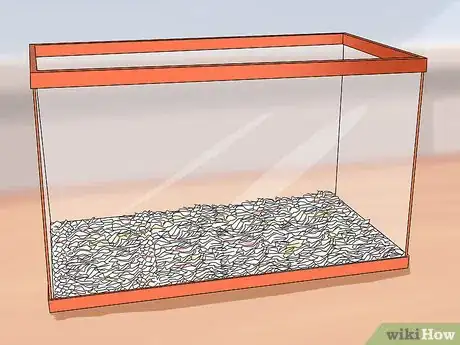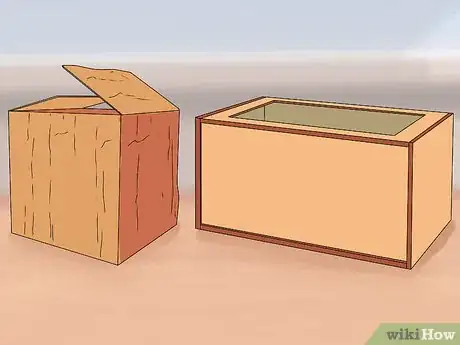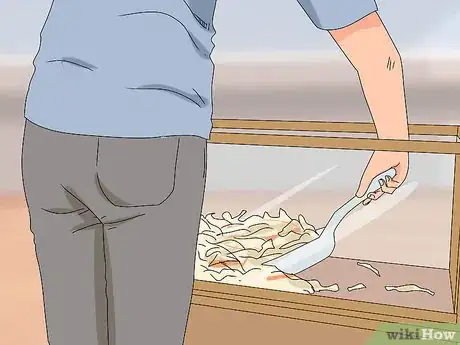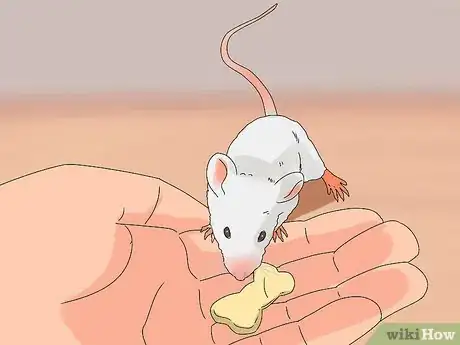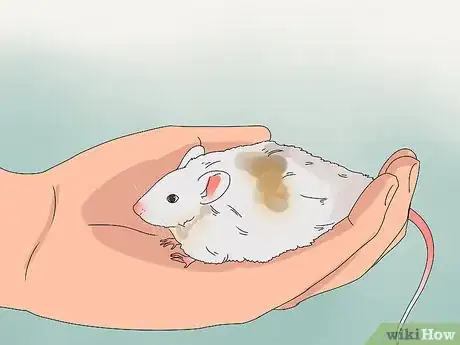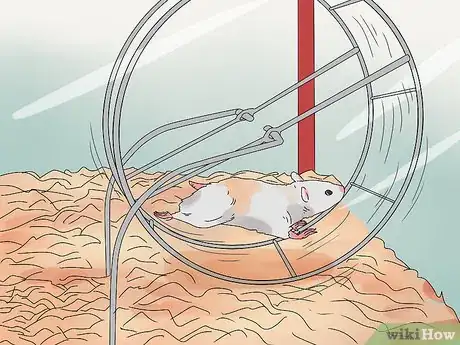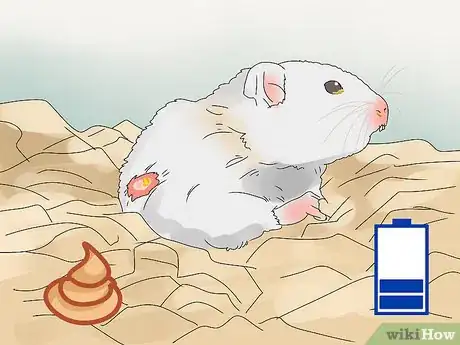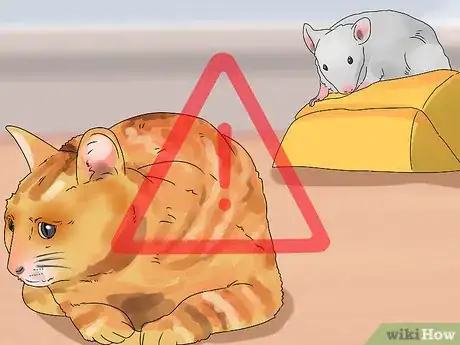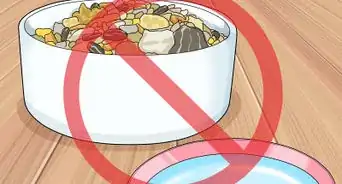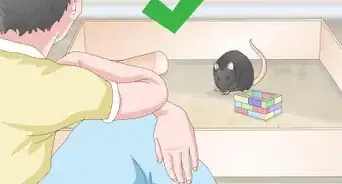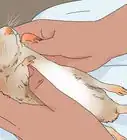This article was co-authored by wikiHow Staff. Our trained team of editors and researchers validate articles for accuracy and comprehensiveness. wikiHow's Content Management Team carefully monitors the work from our editorial staff to ensure that each article is backed by trusted research and meets our high quality standards.
wikiHow marks an article as reader-approved once it receives enough positive feedback. This article received 33 testimonials and 93% of readers who voted found it helpful, earning it our reader-approved status.
This article has been viewed 465,548 times.
Learn more...
Mice are great pets for people of all ages and are fairly easy to care for. You should start by providing the right housing. An aquarium or wire cage with proper substrate is great for a mouse. You should also feed your mouse the right diet. A combination of commercial food and treats works best for a mouse. You should also make sure your mouse is healthy. Make sure it gets enough exercise and take it to the vet if you notice changes in behavior such as a lack of energy.
Steps
Providing Housing
-
1Get the right aquarium size. An aquarium can be a good choice to keep mice. If you opt for an aquarium, make sure it's at least 10 gallons (about 38 liters) and has a mesh lid to prevent a mouse from escaping. If you have one to three mice, a bigger aquarium is necessary.[1]
- Four to five mice need at least a 15 gallon (about 58 liters) aquarium. Five to six mice need a 20 gallon (about 78 liters) aquarium.
- In general, however, bigger is better for any mouse. Get as big of an aquarium as you can fit in your home.
-
2Use a wire cage. A wire cage is also an option for mice. While an aquarium is usually a better option, you can opt for a cage if you cannot find an aquarium. If you get a cage, make sure to select one that's safe for mice. The size of the cage should be at least 24 by 12 inches (about 61 by 30 centimeters). There should be no more than a quarter inch between wires, as this will prevent mice from escaping.[2]Advertisement
-
3Add substrate. Substrate is the material lining the bottom of the cage. For mice, opt for shredded paper that does not contain ink. Line this on the bottom of the cage. A few centimeters of substrate is adequate for a mouse.[3]
-
4Place the enclosure in the right location. Mice are sensitive to heat and cold, so it's important to keep them in an area that's consistently room temperature. Do not put your mouse's enclosure next to heaters, furnaces, or other sources of heat. You should also avoid cold, drafty rooms.[4]
-
5Avoid dangerous houses. Certain types of houses are dangerous for mice. Never keep a mouse in a cardboard box or a wooden enclosure, as mice may chew through these materials. You should also be careful about mice habitats, with a lot of tubes and accessories, sold at pet stores. Mice can get trapped and injured in these kinds of enclosures.[5]
-
6Clean the cage regularly. A mouse's enclosure needs daily cleaning. Each day, use a cat litter scoop to remove soiled bedding. Once a week, you should give the enclosure a thorough cleaning.[6]
- Place your mice in a separate container. Remove all the bedding, any cardboard toys, and food and water bowls.
- Use dish washer detergent and water to wash the insides of the enclosure, as well as food and water bowls and plastic toys. Allow everything to dry completely.
- Replace all the bedding with new material. Place food and water bowls, as well as plastic toys, back in the cage. Discard old cardboard toys and replace them with new ones.
Feeding Your Mouse
-
1Provide commercial food. Pellets and seeds are sold in pet stores specifically for mice. Mice do not require a lot of food. A tablespoon of pellets or seeds per mouse should be enough.[7]
- Go for a ceramic bowl over a plastic one as these tend to be sturdier and more resistant to chewing.
- Pick a smaller bowl. You do not want the bowl to take up a lot of space in your mouse's home.
- Make sure to place the food bowl far away from the bathroom area.
-
2Add treats on occasion. Healthy treats are okay once in a while and can help with your mouse's health. Dog biscuits or treat branches are good for chewing. You can also give your mouse fresh fruits and vegetables from your own kitchen.[8]
- Feed your mouse things like greens, blueberries, and apples once a day. Opt for small amounts and chop bigger fruits into pieces to help your mice easily swallow them.You can also feed them grains, seeds,hay,etc.
-
3Feed your mice at the right time. Mice are nocturnal, so it's best to provide food close to nighttime. You should also provide a continual supply of water at all hours of the day.[9]
- Make sure to set some kind of alarm or alert. Mice need food every day, so you should not skip meals. It's like you skipping a days worth of food.
Keeping Your Mice Healthy
-
1Handle your mice properly. Mice are generally afraid of people, so minimize how often you handle your mouse. When you do pick up your mouse, do so in a safe fashion. Set a treat in your palm then lay your hand flat at the bottom of its cage. When it climbs on, gently lift it up into the air. Hold your mouse close to your lap if it is not comfortable being held. You can then pet and interact with your mouse. If your mouse is squirming and nervous, place it back in its cage.
- Never grab a mouse by the tip of its tail and do not squeeze a mouse with your fingers.
-
2Make sure your mice get enough exercise. Mice are active animals that need plenty of exercise to stay healthy. An exercise wheel is vital for any mouse's cage. However, always opt for a plastic one over a wire one. Mice can easily get trapped and injured or even killed in a wire wheel.[10]
- You should also provide toys. Inexpensive toys, like cardboard rolls from paper towels and toilet paper, are safe for mice to play with. You can also pick up commercial toys from a local pet store.
-
3Watch for signs of health problems. Mice should be active and alert. They should eat and drink regularly and breathe and walk steadily. If you notice any of the following changes in behavior, see a vet:[11]
- Lack of appetite
- Lethargy
- Discharge from the eyes or nose
- Diarrhea
- Weight loss
- Skin lesions
- Overgrown teeth
-
4Avoid extreme heat and cold. Extreme temperatures can cause health problems and even death in mice. Make sure you keep your mice in an area in your home that's room temperature. If anything causes a sudden change in temperature, such as a heat outage, move your mouse to a location where temperature is stable.[12]
-
5Keep your mice away from other household pets. Household pets like cats and dogs may view mice as prey. Pets like ferrets and snakes may also prey on mice. Keep mice in separate rooms from other pets and make sure their cages are secure at all times.[13]
Community Q&A
-
QuestionAre mice good pets for little kids?
 Community AnswerYes, but if the child is younger than about 8, they should always be supervised when handling the mice, and they should be kept out of reach in case the child decides to hold it without permission. Young children also touch things that they shouldn't, like their noses or mouths, so have them wash their hands after handling the mice. An adult should also make sure that the mice are being properly cared for, in terms of feeding, keeping the cage clean, etc.
Community AnswerYes, but if the child is younger than about 8, they should always be supervised when handling the mice, and they should be kept out of reach in case the child decides to hold it without permission. Young children also touch things that they shouldn't, like their noses or mouths, so have them wash their hands after handling the mice. An adult should also make sure that the mice are being properly cared for, in terms of feeding, keeping the cage clean, etc. -
QuestionCould I feed the mouse cheese?
 CaeiiaTop AnswererThey are lactose intolerant, so no. It would do more harm than good.
CaeiiaTop AnswererThey are lactose intolerant, so no. It would do more harm than good. -
QuestionMy mice are very lazy. What should I do to make them active?
 GerbilosCommunity AnswerI would recommend adding more toys and enrichment items to their cage.
GerbilosCommunity AnswerI would recommend adding more toys and enrichment items to their cage.
Warnings
- Never pick up a mouse by the tip or middle of its tail. This is painful for them and can cause injuries to your mouse.⧼thumbs_response⧽
References
- ↑ http://www.humanesociety.org/animals/mice/tips/mouse_housing.html?credit=web_id139895614?referrer=http://www.humanesociety.org/animals/mice/tips/mouse_tips.html
- ↑ http://www.humanesociety.org/animals/mice/tips/mouse_housing.html?credit=web_id139895614?referrer=http://www.humanesociety.org/animals/mice/tips/mouse_tips.html
- ↑ https://www.vetbabble.com/small-pets/mice/
- ↑ http://www.humanesociety.org/animals/mice/tips/mouse_housing.html?credit=web_id139895614?referrer=http://www.humanesociety.org/animals/mice/tips/mouse_tips.html
- ↑ http://www.humanesociety.org/animals/mice/tips/mouse_housing.html?credit=web_id139895614?referrer=http://www.humanesociety.org/animals/mice/tips/mouse_tips.html
- ↑ http://animals.mom.me/control-odor-mouse-cage-1540.html
- ↑ http://www.humanesociety.org/animals/mice/tips/mouse_feeding.html?credit=web_id139895614
- ↑ http://www.humanesociety.org/animals/mice/tips/mouse_feeding.html?credit=web_id139895614
- ↑ http://www.humanesociety.org/animals/mice/tips/mouse_feeding.html?credit=web_id139895614
About This Article
To take care of mice, set up a roomy aquarium or wire cage for housing and line the bottom with a few centimeters of blank shredded paper. Next, place commercial mouse food like pellets and seeds in a small ceramic bowl and put the bowl inside the cage. It's also important to include an exercise wheel and other toys to keep your mice occupied and active. If you notice any symptoms of illness, such as lack of appetite, lethargy, diarrhea, and weight loss, take your mice to the vet as soon as possible. For tips on picking up a mouse properly, read on!
